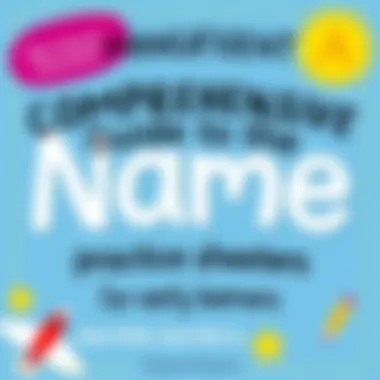Comprehensive Guide to Name Practice Sheets for Kids


Intro
In the realm of early education, name practice sheets have emerged as subtle yet powerful tools for fostering both writing skills and a sense of identity in young learners. For toddlers and preschoolers, recognizing their name is akin to finding a piece of themselves in a world full of letters and sounds. These sheets serve not just as a canvas for practicing penmanship but also as a gateway to more profound cognitive development. This guide lays bare the essence of name practice sheets, exploring their multifaceted role in shaping early literacy and personal growth.
The beauty of name practice sheets lies in their simplicity and adaptability, appealing to both children and educators alike. They can be tailored to various learning styles, ensuring that each child can engage with their name creatively and meaningfully. As we delve deeper, we will discuss strategies for effective implementation, the types of sheets available, and enrichments you can apply to these resources to enhance their educational impact. Let's uncover the layers of how these sheets can transform learning into a fun and engaging experience.
Understanding Name Practice Sheets
Name practice sheets play a pivotal role in the landscape of early education. These sheets are not just blank pages waiting to be filled with ink; they are essential tools designed to nurture foundational literacy skills in young learners. The concept revolves around two core objectives: developing writing proficiency and fostering a deep-rooted sense of identity. Understanding the nuances and applications of name practice sheets can significantly enhance their effectiveness in both home and educational settings.
Definition and Purpose
Name practice sheets, in their simplest form, consist of pre-designed templates that guide children in writing their names. These sheets are tailored to provide structured practice, commonly featuring various formats such as dotted lines for tracing, empty spaces for freehand writing, and even engaging images that resonate with a child’s sense of self. The primary purpose of these sheets is to not only teach letter formation but also to instill a sense of ownership and pride in one’s name. Names are not just labels; they encapsulate personal history and dignity. Thus, practicing how to write one’s name is an important first step in a child’s educational journey.
A well-crafted name practice sheet can act as a springboard for skill mastery and confidence. By adhering to different styles—whether cursive, print, or even artistic variations—children can explore their individual writing preferences, making the learning process interactive and enjoyable. Furthermore, these sheets can also serve to reinforce phonetic awareness, as recognizing and writing one's name involves associating sounds with letters.
Importance in Early Education
The significance of name practice sheets in early education cannot be overstated. First off, they lay the groundwork for essential writing skills that children will build upon as they progress through their schooling. When children engage with these sheets, they not only practice fine motor skills through writing but also develop cognitive connections between letters and sounds. This multi-faceted approach enhances their overall literacy foundation.
Moreover, practicing one’s name encourages recognition and recall, vital skills as children enter a more social learning environment where their identity plays a crucial role.
Additionally, name practice sheets contribute to a child’s sense of self-worth. Knowing how to spell and write their name gives a child a unique identity marker, setting the stage for feelings of accomplishment. It serves as a personal milestone that can motivate them to engage further in learning.
Lastly, integrating name practice sheets within a diverse curriculum opens doors to exciting discussions around culture, heritage, and individuality. By exploring names from various backgrounds, educators can create inclusive environments that celebrate diversity and enrich a child’s understanding of the world.
In essence, the understanding of name practice sheets is more than a mere look at educational tools; it encompasses the critical interplay between identity, language, and early writing development. This holistic understanding lays the foundation for effectively incorporating these sheets into learning experiences, ensuring they serve their intended purpose while being engaging and relevant to young learners.
Key Benefits of Name Practice Sheets
Name practice sheets serve as essential tools in the upbringing and development of young learners. As children engage with these sheets, they not only begin to form letters, but they also tap into other layers of their growth. The benefits extend beyond mere handwriting. Let's dive deeper.
Development of Writing Skills
Writing is an intricate skill. It involves muscle memory, hand-eye coordination, and an understanding of letter formation. Name practice sheets provide a guided path for children to hone their writing skills. The repetition of writing their name fosters a natural learning curve, enabling them to grasp the mechanics behind letter formation.
It's more than just putting pen to paper; it is about building confidence. When a child sees their name in print and is able to replicate it, there’s a sense of ownership and pride that accompanies this achievement. Moreover, the consistency in practicing can lead to improved legibility and speed in writing as they progress.
Fostering Personal Identity
A child’s name is not just a label; it is a vital part of their identity. Name practice sheets play a pivotal role in helping children recognize and embrace who they are. Writing their name over and over allows them to see its uniqueness and to connect emotionally with it. This connection lays the groundwork for personal growth and self-esteem.
Understanding one's identity begins with something as simple as writing their name. Each stroke represents a piece of who they are.
As they practice, children learn to value their individuality. This foundational aspect has implications that go beyond the classroom; it can influence their interactions with peers and their perception of themselves in various social settings.
Enhancing Cognitive Development
Cognitive development in early childhood is crucial for future learning capacities. Engaging with name practice sheets stimulates several cognitive functions. As children learn to write their names, they also enhance their memory skills. They must recall not only the letters but also the order in which they are arranged.
This kind of activity encourages critical thinking. As they progress, they may begin to differentiate between the letters or explore how their names look in upper and lower case.
Overall, the interaction with name practice sheets can strengthen various cognitive domains, paving the way for increased academic success later on.
In summary, the importance of name practice sheets far surpasses the simple act of writing. These sheets serve as an entry point for children to develop writing skills, foster their unique identities, and enhance cognitive capabilities—all invaluable assets as they navigate their educational journeys.
Types of Name Practice Sheets


When it comes to name practice for early learners, the variety of practice sheets available plays a crucial role in capturing children’s interest while also catering to their individual learning needs. Understanding the different types of name practice sheets allows parents and educators to contribute to a child’s learning process more effectively. Each type serves a unique purpose, helping children develop writing skills, build confidence, and enhance their identity through personal engagement. Here are the most common types of name practice sheets:
Traditional Handwriting Sheets
Traditional handwriting sheets are the classic approach to name practice. They typically feature blank spaces where children can trace or write their names repeatedly. The sheets often come lined, providing visual cues on how to align letters properly. This method not only aids in building motor skills but also reinforces letter recognition.
Advantages of traditional handwriting sheets include:
- Structured learning: The lined format helps maintain proper size and shape of letters.
- Familiarity: Many children are already accustomed to this type of practice, making it easier to engage with.
- Tactile experience: Writing by hand enhances neurological connections in young brains, further fostering learning.
Incorporating traditional handwriting sheets into practice can lay a strong foundation for future writing endeavors. They can be easily created at home or found online, such as on educational websites like Education.com or Teachers Pay Teachers.
Interactive Digital Sheets
With technology permeating every aspect of life, it’s no surprise that interactive digital name practice sheets have gained traction. These sheets allow children to practice writing on tablets or computers, creating an engaging learning environment. Many educational apps are designed specifically for this purpose, featuring fun animations and immediate feedback for the learner.
The benefits of interactive digital sheets include:
- Engagement: Colorful graphics and sound effects hold children's attention much longer than traditional methods.
- Flexibility: Children can practice anywhere and anytime, making it easier to fit into busy schedules.
- Immediate feedback: Many apps provide instant correction which can help children learn from their mistakes in real-time.
Some popular platforms with interactive name practice options are Khan Academy and ABCmouse.
Creative DIY Practice Sheets
DIY practice sheets are a dynamic way to combine creativity with education. Parents and teachers can create unique practice sheets that cater specifically to a child's interests. Whether it's using favorite colors, images, or formats, making the practice more personal can inspire children to participate eagerly.
Benefits of creative DIY practice sheets include:
- Customization: You can tailor worksheets to feature a child’s hobbies or favorite characters, making them more appealing.
- Creative skills: Designing these sheets can be a project on its own, allowing for parental and child involvement.
- Increased enthusiasm: Engaging with personalized sheets can motivate hesitant learners to practice writing their names.
To get started, simple tools like colored paper, stickers, or printable templates from websites like Canva can empower parents and caregivers to design enjoyable practice activities.
"Tailoring name practice sheets provides creative ways to engage children, making the educational process enjoyable and effective."
Overall, the diverse range of name practice sheets—from traditional to digital and creative DIY versions—ensures that every child can find a method that suits their learning style. By mixing different types, you can create a rich learning experience that builds not only writing skills but also a child’s confidence and sense of identity.
Implementing Name Practice Sheets at Home
Implementing name practice sheets at home is a crucial aspect of nurturing early literacy in children. These sheets offer a practical framework for fostering writing skills while allowing children to express their individuality. When structured appropriately, practice sheets become more than just tools for writing; they also promote a sense of accomplishment and preferred identity among young learners. Integrating these activities into daily life not only supports developmental milestones but also encourages curiosity and exploration in a low-pressure environment.
Creating a Structured Routine
Establishing a structured routine is vital when implementing name practice sheets at home. Children thrive on predictability, and by setting aside specific times for practice, parents can normalize writing as part of daily life. This doesn’t have to be a marathon session of endless writing. In fact, short bursts of focused activity work wonders. Aim for 10 to 15 minutes, and quickly observe if the child remains engaged.
Here are a few tips for creating a solid routine:
- Choose a consistent time: Whether during breakfast or just before bedtime, find a time when the child is most receptive. This predictability can make them look forward to these sessions.
- Create a comfortable space: Ensure that the writing environment is clear of distractions. A cozy nook with colorful supplies can uplift the experience unexpectedly.
- Use visuals: Having a calendar or a visual timer can help the child see how much time they have left, making them feel more in control.
By focusing on consistency, children are more likely to develop a keen interest in writing, ultimately leading to better handwriting skills.
Incorporating Play-Based Learning
Incorporating play-based learning while using name practice sheets can be a transformative way to keep engagement levels high. Play is a natural method through which children absorb information, making it an excellent vehicle for teaching writing. By weaving in elements of fun, parents can balance the sometimes monotonous task of writing.


Consider these strategies for merging learning with fun:
- Create themed practice sheets: Develop sheets that connect to your child’s favorite characters or stories. For example, if they love dinosaurs, include dinosaurs in the illustrations on the sheet. This contextual connection can make the task more enticing.
- Include physical movement: Transform the writing practice into a game. For instance, you could write their names on balloons and have them pop one each time they finish a letter. As silly as it sounds, it adds a lively twist to improve concentration.
- Rhythm and music: Use songs or jingles to emphasize the letters in their name. Singing letters boosts memory and provides a multisensory approach, accommodating different learning styles.
"Incorporating play leads to a more enjoyable learning experience, making the idea of writing fun and engaging rather than tedious or burdensome."
Utilizing Name Practice Sheets in the Classroom
In the realm of early education, name practice sheets serve as a vital tool for both teachers and young learners. These resources not only aid in the development of basic writing skills but also enhance personal identity formation, which is particularly significant during the formative years.
Effective utilization of name practice sheets in classrooms can revolutionize the way handwriting is taught, transforming what can sometimes be considered a tedious chore into an engaging and interactive experience. Teachers can leverage these sheets to integrate name writing into various aspects of the curriculum, maximizing the learning potential of their students.
Integrating with Curriculum Objectives
When it comes to integrating name practice sheets with curriculum objectives, the approach can be quite strategic. Name writing can be linked to literacy goals and social development targets. For instance, when educators align name practice activities with literacy lessons, they help students recognize the connection between letters and sounds in a meaningful way. A few points to consider include:
- Writing Development: It’s crucial that educators ensure name practice emphasizes correct letter formation. This helps refine motor skills while promoting legibility.
- Phonemic Awareness: Discussing the sounds represented by letters in a child’s name allows for phonics reinforcement.
- Cultural and Social Relevance: Many names bear cultural significance. Integrating name writing with history or social studies lessons can foster an appreciation for diversity and personal heritage.
By embedding these practice sheets into various subjects, teachers create a purposeful connection between personal identity formation and academic skills, making the learning experience holistic.
Assessing Progress through Observation
Observation in the classroom is an essential practice for understanding how well children are absorbing and applying their newly acquired skills. Name practice sheets offer a unique opportunity for informal assessment. Observing a child as they engage with these practice sheets can yield critical insight into their progress. Here's why this method of assessment is effective:
- Real-Time Feedback: Teachers can provide immediate support and encouragement as students practice writing their names. This fosters a supportive learning environment where students feel safe to make mistakes and learn from them.
- Identifying Areas for Improvement: Through observation, a teacher may notice specific letters that a child struggles with, allowing for targeted intervention to help the child improve their handwriting skills.
- Building Confidence: As students successfully write their names, they gain confidence in their abilities. This can motivate them to tackle more complex writing tasks.
"Engagement in practice leads to mastery. When a child learns to write their name, they unlock a piece of their identity."
In summary, utilizing name practice sheets in the classroom paves the way for integrating essential curriculum objectives while simultaneously providing a framework for assessing student progress. This not only fosters foundational writing skills but also nurtures personal growth, all while keeping the learning experience vibrant and purposeful.
For further insights on educational strategies, you might find this resource from Britannica useful, along with tools available at edu.gov that outline effective early childhood literacy practices.
Tailoring Name Practice Sheets for Diverse Learners
Tailoring name practice sheets for diverse learners is crucial in fostering an inclusive environment that encourages every child's growth and development. Children come with a myriad of backgrounds, learning preferences, and abilities. By customizing practice sheets, we can address those unique needs, enhancing both engagement and effectiveness in learning.
Accommodating Different Learning Styles
Every child has a distinct way of absorbing and processing information. Some might be visual learners, while others may grasp concepts better through auditory or kinesthetic methods.
- Visual Learners: These children thrive with colorful layouts, graphics, and illustrations on their name practice sheets. Adding images relevant to their names or incorporating fun fonts can make the process enjoyable.
- Auditory Learners: They benefit from verbal instructions or background sounds. Utilizing voice recording tools where parents or educators say the letter sounds as the child writes can help reinforce learning through sound.
- Kinesthetic Learners: These learners excel with hands-on experiences. Designing practice sheets that allow for activities like tracing names with tactile materials such as sand or clay encourages active participation, making the learning stick.
An important aspect of adapting content is knowing your child well enough to determine their preferred learning style. Through ongoing observations, parents and educators can make informed choices on how best to design these practice sheets.
Adapting for Special Needs
Adapting name practice sheets for children with special needs requires a thoughtful approach. Not every child will learn or express their skills in the same way, and understanding that is key to successful implementation.
- Dyslexia: Children struggling with dyslexia may find it helpful to use larger fonts, bright colors, and a mix of print and cursive letters. They should have the opportunity to practice letters in various contexts, not just through repetition.
- Autism Spectrum Disorder: For some children on the autism spectrum, incorporating familiar symbols or characters can aid in recognition and ownership of their name. This tailored approach can build comfort and create a personal connection with their learning materials.
- Motor Skill Challenges: For those facing fine motor skill difficulties, using thicker writing tools or textured sheets allows them to learn in a less frustrating manner. It's also beneficial to create sheets that employ varied formats, like dotted lines or tactile elements promoting grip improvement.
In essence, customizing name practice sheets is about understanding the individual needs of diverse learners. It entails flexibility in teaching strategies and maintaining a commitment to every child's potential, ensuring that each practice session brings about genuine progress and confidence.
Addressing Challenges with Name Practice Sheets


Utilizing name practice sheets can offer an array of benefits, yet the journey often comes with its set of challenges. Understanding and addressing these hurdles is crucial for maximizing the efficiency and effectiveness of these learning tools. This section delves into common obstacles and provides insight into overcoming them, ultimately supporting young learners in developing their writing skills and sense of identity.
Overcoming Resistance to Writing
Young children can sometimes show a stubborn reluctance to engaging in writing tasks. This pattern of resistance, albeit frustrating for parents and educators alike, can often reflect underlying anxiety or lack of confidence in their writing abilities. To address these feelings head-on, it's important to foster a positive and encouraging environment.
- Start Small: Instead of overwhelming a child with long name practice sheets, begin with short, manageable tasks. This approach builds confidence and allows them to experience a sense of accomplishment quickly.
- Use Relatable Context: Tailoring the practice sheets to include favorite characters or themes that resonate with the child can pique their interest. For instance, if a child loves animals, incorporating a worksheet that involves writing their name alongside pictures of their favorite animals can make the activity more engaging.
- Celebrate Efforts, Not Just Results: Acknowledging effort—regardless of the final product—can motivate children to keep trying. Verbal praise, stickers, or simply a high-five can reinforce the idea that their practice is valued.
"The journey of a thousand miles begins with one step."
Maintaining Engagement and Motivation
Keeping children engaged in name practice is about ensuring that each learning experience feels fresh and exciting. Boredom can easily creep in, leading to disinterest and disengagement from the writing process. Here are some strategies to maintain motivation:
- Incorporate Technology: Leveraging educational apps that focus on letter formation can provide instant feedback, making the learning process feel dynamic and interactive.
- Gamify the Experience: Creating competitions or games around writing names can add an element of fun. For instance, organizing a race to see who can write their name the fastest (with the correct spelling, of course) can spur enthusiasm.
- Creative Variations: Experimenting with various materials can spice up the practice sheets. Instead of pen and paper, kids can use sand, playdough, or even paint to form the letters of their name. These tactile experiences help in solidifying their learning.
Using Technology to Enhance Name Practice
In today’s digital age, incorporating technology into early learning can have a significant impact on how children engage with educational activities, particularly when it comes to name practice. Leveraging technology can make learning more accessible, interactive, and enjoyable. For young learners, the use of various technological tools not only breaks the monotony of traditional practice sheets but also aligns with their natural affinity for digital devices. By embracing these tools, parents and educators can create a rich learning environment that fosters both skill acquisition and motivation.
Educational Apps and Online Resources
There’s no shortage of educational apps and online platforms that cater to young children learning to write their names. Many of these resources come equipped with fun, engaging interfaces that can capture a child's attention effectively. Here are some popular options:
- ABCmouse: This comprehensive program offers a full curriculum and includes handwriting practice sections tailored for name recognition and writing.
- Endless Alphabet: This app introduces letters through cute animations and helps children learn the letters in their names interactively.
- Writing Wizard: A handwriting app that allows children to trace their names while providing helpful visual guidance.
Utilizing these apps not only reinforces name writing skills but also promotes cognitive development. Children can progress at their own pace, which is vital for building confidence. Furthermore, these platforms often come packed with assessments and progress tracking features, enabling parents and teachers to monitor improvements effectively.
Creating Interactive Practice Sheets
Designing interactive practice sheets can transform the traditional approach to writing names. These sheets allow for a hands-on experience, mixing writing with activities that engage other senses. Here are some ideas for creating these sheets:
- Coloring and Tracing: Combine coloring activities with tracing names. Children can color in letters while practicing how to write them. This multisensory approach helps to blend creativity with learning.
- Find and Write: Create a worksheet that has the child search for their name hidden among other letters or words. Once they find it, they can practice writing it several times on the same sheet.
- Sensory Materials: Encourage children to write their names using textured materials (sand, fabric, or paint). Following this, have them complete a practice sheet to reinforce the skills they practiced.
It’s essential that these interactive sheets are visually appealing and age-appropriate to hold children's attention. Bright colors, engaging images, and a layout that’s easy to follow can make the task of writing their names feel like a game rather than a chore.
Emphasizing the connection between fun and learning can lead to a more positive experience during name practice, ultimately enhancing a child’s interest in writing.
Through technology and creativity, name practice can become an enjoyable journey for children, cementing their ability to recognize and write their names effectively.
Closure
The significance of using name practice sheets extends far beyond mere handwriting exercises. These sheets serve as a foundational tool in the early educational journey, particularly for young learners. They not only bolster writing skills but are also pivotal in fostering a child's personal identity. Understanding and expressing one’s name can enhance a child's self-esteem and sense of belonging. Recognizing the role of one's name is often the first step towards self-recognition in their developing world.
Moreover, name practice sheets can work wonders for cognitive development. As children engage in repetitive writing of their names, they unwittingly sharpen their memory, attention, and fine motor skills. This repetition lays the groundwork for complex language and writing skills down the line. Educators and parents can thus leverage these sheets as a consistent touchstone for learning, embedding critical thinking and creativity into each practice session. For teachers, integrating name practice into the curriculum not only enriches learning but also builds a supportive environment where learners thrive.
In the end, the journey of learning one’s name through tailored practice sheets presents an opportunity to weave together various aspects of early education. It becomes an engaging task that promotes essential skills while letting children express their unique individuality, thus capturing the very essence of their growth.
Summary of Key Points
- Name practice sheets are essential educational tools promoting handwriting skills, personal identity, and cognitive growth.
- Encouraging young learners to write their names helps build self-esteem and a sense of belonging in their environments.
- Consistent use of name practice sheets can enhance memory, attention, and fine motor skills, all of which are vital for future learning.
- Practical strategies for implementation at home and in classrooms ensure that children's engagement remains high.
- Customizing practice sheets to the needs of diverse learners can maximize the effectiveness of the practice.
Encouragement for Continued Use
Maintaining consistent practice with name sheets should not be viewed as a chore but as an integral part of a child's learning experience. For both parents and educators, fostering a love for writing can be rooted in these unique tools. Regularly revisiting name practice—whether through traditional, digital, or do-it-yourself sheets—can keep the activity fresh and exciting.
As children grow and their skills evolve, so too should the complexity and creativity of their practice sheets. Encouraging them to personalize their sheets, perhaps by using colors or themes that resonate with their interests, can further engage their imagination.
Ultimately, name practice sheets are more than just paper filled with lines and letters; they signify the very identity of the learners themselves. By nurturing this vital aspect of their learning journey, parents and educators build a strong foundation for a lifetime of curiosity and personal growth. Thus, continue utilizing these resources, adapt to each child’s needs, and watch them flourish.















